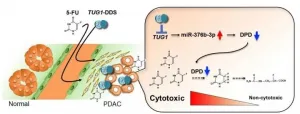(Press-News.org) By cracking open a cellular membrane, Northwestern University synthetic biologists have discovered a new way to increase production yields of protein-based vaccines by five-fold, significantly broadening access to potentially lifesaving medicines.
In February, the researchers introduced a new biomanufacturing platform that can quickly make shelf-stable vaccines at the point of care, ensuring they will not go to waste due to errors in transportation or storage. In its new study, the team discovered that enriching cell-free extracts with cellular membranes -- the components needed to made conjugate vaccines -- vastly increased yields of its freeze-dried platform.
The work sets the stage to rapidly make medicines that address rising antibiotic-resistant bacteria as well as new viruses at 40,000 doses per liter per day, costing about $1 per dose. At that rate, the team could use a 1,000-liter reactor (about the size of a large garden waste bag) to generate 40 million doses per day, reaching 1 billion doses in less than a month.
"Certainly, in the time of COVID-19, we have all realized how important it is to be able to make medicines when and where we need them," said Northwestern's Michael Jewett, who led the study. "This work will transform how vaccines are made, including for bio-readiness and pandemic response."
The research will be published April 21 in the journal Nature Communications.
Jewett is a professor of chemical and biological engineering at Northwestern's McCormick School of Engineering and director of Northwestern's Center for Synthetic Biology. Jasmine Hershewe and Katherine Warfel, both graduate students in Jewett's laboratory, are co-first authors of the paper.
The new manufacturing platform -- called in vitro conjugate vaccine expression (iVAX) -- is made possible by cell-free synthetic biology, a process in which researchers remove a cell's outer wall (or membrane) and repurpose its internal machinery. The researchers then put this repurposed machinery into a test tube and freeze-dry it. Adding water sets off a chemical reaction that activates the cell-free system, turning it into a catalyst for making usable medicine when and where it's needed. Remaining shelf-stable for six months or longer, the platform eliminates the need for complicated supply chains and extreme refrigeration, making it a powerful tool for remote or low-resource settings.
In a previous study, Jewett's team used the iVAX platform to produce conjugate vaccines to protect against bacterial infections. At the time, they repurposed molecular machinery from Escherichia coli to make one dose of vaccine in an hour, costing about $5 per dose.
"It was still too expensive, and the yields were not high enough," Jewett said. "We set a goal to reach $1 per dose and reached that goal here. By increasing yields and lowering costs, we thought we might be able to facilitate greater access to lifesaving medicines."
Jewett and his team discovered that the key to reaching that goal lay within the cell's membrane, which is typically discarded in cell-free synthetic biology. When broken apart, membranes naturally reassemble into vesicles, spherical structures that carry important molecular information. The researchers characterized these vesicles and found that increasing vesicle concentration could be useful in making components for protein therapeutics such as conjugate vaccines, which work by attaching a sugar unit -- that is unique to a pathogen -- to a carrier protein. By learning to recognize that protein as a foreign substance, the body knows how to mount an immune response to attack it when encountered again.
Attaching this sugar to the carrier protein, however, is a difficult, complex process. The researchers found that the cell's membrane contained machinery that enabled the sugar to more easily attach to the proteins. By enriching vaccine extracts with this membrane-bound machinery, the researchers significantly increased yields of usable vaccine doses.
"For a variety of organisms, close to 30% of the genome is used to encode membrane proteins," said study co-author Neha Kamat, who is an assistant professor of biomedical engineering at McCormick and an expert on cell membranes. "Membrane proteins are a really important part of life. By learning how to use membrane proteins effectively, we can really advance cell-free systems."
INFORMATION:
The study, "Improving cell-free glycoprotein synthesis by characterizing and enriching native membrane vesicles," was supported by the Defense Threat Reduction Agency (award number HDTRA1-15-10052/P00001), the National Science Foundation (award numbers 1936789 and 1844336), the Air Force Research Laboratory Center of Excellence (award number FA8650-15-2-5518), the Bill & Melinda Gates Foundation (award number OPP1217652), the David and Lucile Packard Foundation and the Camille Dreyfus Teacher-Scholar Program.
BOSTON -- Radiation therapy is used as a treatment for more than half of all cancer patients and can be highly effective at shrinking tumors and killing cancer cells. But radiation treatment can also damage healthy tissue, including tissue in the mouth and gastrointestinal tract. This tissue injury can lead to oral mucositis, esophagitis, and proctitis -- painful and sometimes debilitating tissue damage. It's estimated that these injuries occur in over 200,000 patients in the U.S. each year. In a new paper published in Advanced Science, investigators from Brigham and Women's Hospital, Dana-Farber Cancer Institute, Massachusetts General Hospital and ...
Bottom Line: When given a choice, most individuals with an average risk of colorectal cancer said they would prefer a stool-based screening test for colorectal cancer over colonoscopy, the method most often recommended by health care providers.
Journal in Which the Study was Published: Cancer Prevention Research, a journal of the American Association for Cancer Research
Author: Xuan Zhu, PhD, senior health services analyst at the Mayo Clinic Robert D. and Patricia E. Kern Center for the Science of Health Care Delivery
Background: Although colorectal cancer is the second most frequent cause of cancer-related death in the United States, about one-third of eligible American adults have never completed a colorectal cancer screening test, ...
Using the Atacama Large Millimeter/submillimeter Array (ALMA), astronomers found a rotating baby galaxy 1/100th the size of the Milky Way at a time when the Universe was only seven percent of its present age. Thanks to assistance by the gravitational lens effect, the team was able to explore for the first time the nature of small and dark "normal galaxies" in the early Universe, representative of the main population of the first galaxies, which greatly advances our understanding of the initial phase of galaxy evolution.
"Many of the galaxies that existed ...
For elite runners competing in long-distance races, every second counts. So when Nike introduced "advanced shoe technology" in 2017, questions arose about whether the new design would significantly affect performances in professional sports. A new paper published in END ...
Nagoya University researchers and colleagues in Japan have uncovered a molecular pathway that enhances chemotherapy resistance in some pancreatic cancer patients. Targeting an RNA to interrupt its activity could improve patient response to therapy and increase their overall survival.
"Pancreatic cancer is one of the most aggressive human malignancies, with an overall median survival that is less than five months," says cancer biologist Yutaka Kondo of Nagoya University Graduate School of Medicine. "This poor prognosis is partially due to a lack of potent therapeutic ...
Robotics field aims at mimicking what natural biological entities have achieved throughout millennia of evolution - actions like moving, adapting to the environment, or sensing. Beyond traditional rigid robots, the field of soft robotics has recently emerged using compliant, flexible materials capable to adapt to their environment more efficiently than rigid ones. With this goal in mind, scientists have been working for years in the so-called biohybrid robots or biobots, generally composed of muscle tissue, either cardiac or skeletal, and an artificial scaffold, achieving crawling, ...
Vigorous and rapid air exchanges might not always be a good thing when it comes to addressing levels of coronavirus particles in a multiroom building, according to a new modeling study.
The study suggests that, in a multiroom building, rapid air exchanges can spread the virus rapidly from the source room into other rooms at high concentrations. Particle levels spike in adjacent rooms within 30 minutes and can remain elevated for up to approximately 90 minutes.
The findings, published online in final form April 15 in the journal Building and Environment, come from a team of researchers at the U.S. Department of Energy's Pacific Northwest National Laboratory. The team includes building and HVAC experts ...
Diseases continue to be a major threat to coral reef health. For example, a relatively recent outbreak termed stony coral tissue loss disease is an apparently infectious waterborne disease known to affect at least 20 stony coral species. First discovered in 2014 in Miami-Dade County, the disease has since spread throughout the majority of the Florida's Coral Reef and into multiple countries and territories in the Caribbean. Some reefs of the northern section of Florida's Coral Reef are experiencing as much as a 60 percent loss of living coral tissue area.
A new study by researchers at Florida Atlantic University's Harbor ...
INDIANAPOLIS -- A team from Regenstrief Institute leveraged OpenMRS, a global open-source electronic medical record (EMR), to create an emergency EMR for Indianapolis first responders preparing for a possible influx of COVID-19 patients. This process was completed in a week to allow Indianapolis Emergency Medical Services (IEMS) to register patients, collect basic clinical information, and send these encounters to Indiana's health information exchange, a crucial element to help the response to the COVID-19 pandemic.
IEMS asked Regenstrief research scientists for help ...
Invasive Group B Streptococcus (GBS) disease, notably meningitis, during the first days and months of a baby's life can have persistent effects for children and hence their families, according to new research. Published in the Lancet Child & Adolescent Health, the study is the first evidence of long-term effects including after GBS sepsis (infection in the bloodstream).
This large study analysed outcomes for nearly 25,000 children born in Denmark and The Netherlands, between 1997 and 2017. Results show that children who had invasive GBS infection are twice as likely to have neurodevelopmental impairments (NDI) and ...





